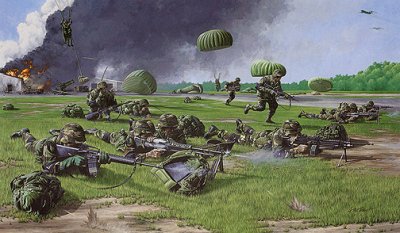
UNITED STATES ARMY POWER PROJECTION IN THE 21st CENTURY: THE CONVENTIONAL AIRBORNE FORCES MUST BE MODERNIZED TO MEET THE ARMY CHIEF OF STAFF'S STRATEGIC FORCE REQUIREMENTS AND THE NATION'S FUTURE THREATS.
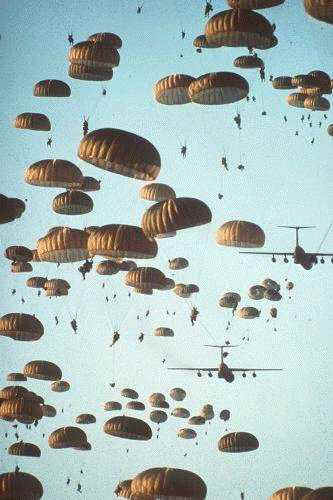

MASTER OF MILITARY ART AND SCIENCE
THESIS APPROVAL PAGE
Name of Candidate: Michael J. Kazmierski , Major, Infantry
Approved by -
Thesis Committee Chairman
Dr. Graniville, Jr.,Ph.D.
Member Graduate Faculty
"Dr." Robert F. Baigiam, Ph. D.
MAJ Dominic J. Cordasco, B.A.
Accepted this 1st day of June 1990 by:
Director, Graduate Degree Programs
Philip J. Brookes, Ph.D.
The opinions and conclusions expressed herein are those of the student author and do not necessarily represent the views of the U.S. Army Command and General Staff College or any other governmental agency. (References to this study should include the foregoing statement.)
ABSTRACT
UNITED STATES ARMY POWER PROJECTION IN THE 21st ARMY: THE CONVENTIONAL AIRBORNE FORCES MUST BE MODERNIZED TO MEET THE ARMY'S STRATEGIC FORCE REQUIREMENTS AND THE NATION'S MAJOR REGIONAL THREATS;
By Major Michael J. Kazmierski, USA, 181 pages.
The modernization of the United States Airborne forces is long overdue. As the Army transitions from a European-based forward deploved force to a "versatile, deployable and lethal" Army, the role of the Airborne forces must increase. Unfortunately, the focus of the military has been on the defense of Europe. Consequently, the Airborne forces have not received the resources necessary to be able to deal with a modern mechanized threat or a 21st Century Third World threat. The author contends that without the immediate modernization of these forces, there is the increasing risk that the Army will be unable to rapidly respond as a strategic force in the very near future. [Kosovo, 1999 anyone?]
This study critically analyzes the evolution of the Airborne forces with a special emphasis on the divergent paths taken by the United States and the [former] Soviet Union. The Soviet Union is used for comparison, not as an adversary but as a nation whose military leadership has embraced the Airborne concept for over 60 years. They have committed years of study, extensive testing and substantial amounts of resources to the modernization of their Airborne forces. The result is a modern, light mechanized, strategic force of over SIX Airborne Divisions that is versatile, deployable and lethal.
EXCLUSIVE! See video clips of Russian Paratroopers jumping followed by ASU-57 Assault Guns and BMD Airborne Infantry Fighting Vehicles!:
www.youtube.com/view_play_list?p=D98B467A57F60F86
www.combatreform.org/russianairbornejumpwithasu57tafv.wmv
More Russian Airborne Videos!
www.combatreform.org/russiandroguechuteandbmdairdrop.wmv
www.combatreform.org/russianairbornebmd1inaction.wmv
Polish Airborne use of Russian D8 drogue parachutes (clearer video)
Note:
1. they jump in front of jet engines because they use drogue chutes not static lines and d-bags; as BMD goes out rear ramp they are jumping in front fuselage to land closer together
2. they can fire AKMs on way down under canopy (we can, too with M4 5.56mm carbines)
3. they have men IN the BMD to speed de-rig and placement into action
4. what they can do with BMD we can do even better with M113 Gavins/M8 Buford/Thunderbolts to give Paratroopers armored mobility/firepower
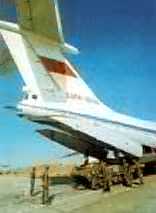
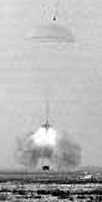
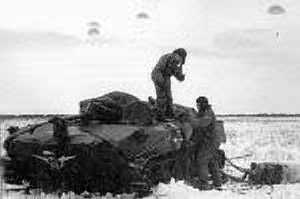
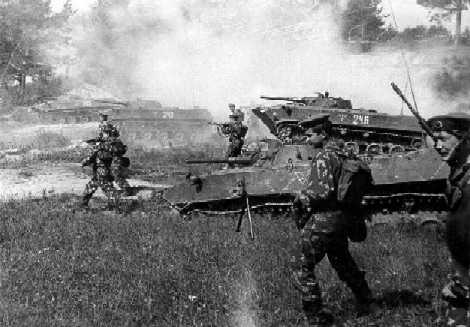
This study continues the comparison of the United States' and the Soviet Union's Airborne forces with a comparative analysis of the current [U.S.] Airborne forces. The comparative analysis focuses on the combat power and the deployability of these forces. Essential concepts are identified and significant capabilities and limitations highlighted. These identified capabilities and limitations are also included in an analysis of the future threat. This threat analysis identifies a significant change in the future threat to strategic forces which includes the proliferation of armored and mechanized forces, modern air defense systems, nuclear and chemical weapons, long-range ballistic missiles, precision guided munitions, sophisticated surveillance systems, and reconnaissance and target acquisition systems. The author concludes that the future threat, especially with regard to its impact on Airborne forced entry, poses serious limitations on the usefulness of the United States Airborne forces, as they are currently designed and equipped.
The author provides recommendations for the modernization of the United States' Airborne forces, based on the requirement for a successful forced entry capability in a future threat environment. This study concludes that the current United States Airborne force is the only force that can provide this nation with the capability of rapidly projecting combat power, anywhere in the world, in the defense of vital interests. However, unless this force is provided significantly more firepower, mobility and survivability, while remaining strategically deployable, the Third World 21st Century threat will prohibit its use.
[Editor's note: Non-use is not an option: world moves by the speed of the AIR. Author's All Mech-Panacea is mirror-reflection of conventionalist "All-Mech or nothing" fatalism rapidly becoming obsolete via Precision Guided Munitions; light, foot-mobile forces can win, but they win easier (less casualties) with the help of light armor. In some cases being foot mobile is MORE mobile than in a vehicle: Vietnam, Korea, Afghanistan etc which must be kept in mind, and why we believe a well-rounded U.S. Airborne with a combination of foot/human powered vehicle, helicopter and light AFV mobility means would be best. As Guderian said after the fall of France in 1940; "It was the TRACK not the tank that won for us". Essentially Maj (now Col) Kazmierski is right-the U.S. Airborne needs an AIRmechanized capability.
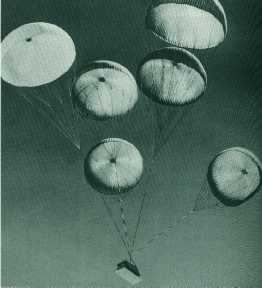
U.S. Army Airborne's BMD: the M113A3 Gavin under canopy
The CAN-DO Russians have even fitted their 100mm/30mm/7.62mm BMP-3 turret onto the smaller BMD Airborne Combat Vehicle, making it the BMD-3M and now the Gavin....what more do we need a sign from god? The Russians have already shown us the way and connected-the-dots for us.
More Russian CAN-DO: BMP-3's 100mm/30mm/7.62mm turret on M113 Gavin AIFV
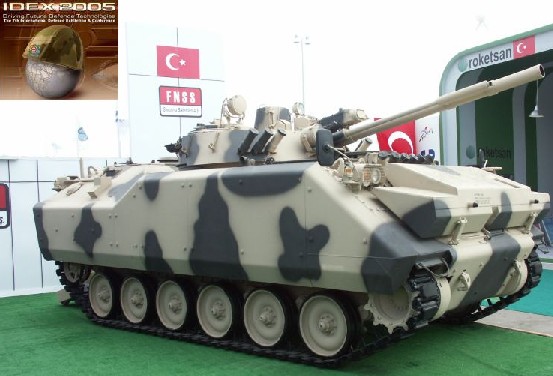
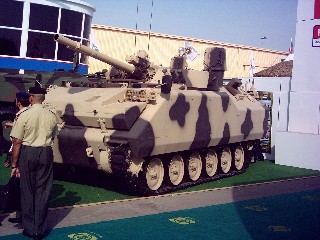
Watch the Turkish Army's FNSS M113 AIFV Gavins in Action!
www.youtube.com/watch?v=YVRmH5FeX9k
More contrast to our current Army/marines focus on buildings, lawn and ego maintenance instead of warfighting!
Other weaknesses (Forgeting the French extensive Airborne troop use in the First Vietnam War, the U.S. Airborne's offensive role in Panama--not defensive "seize and hold" etc. ) are minor compared to this bias against the M113A3. Like so many he at the time the thesis was written wants a "store-bought" solution involving R & D creation of a new vehicle which isn't going to happen and leaves the conservative Army leadership off the hook with a "we do not have the money" excuse. Consider as you read his otherwise superb report that everything Maj Kazmierski wants can be achieved by the 82nd Airborne Division acquiring M113A3 Gavins--a no cost "BMD" which there is NO EXCUSE to not have done years ago. All we have to do is ASK for M113A3 Gavins and the U.S. Airborne will redress its mobility, firepower and protection woes. Otherwise, this IS THE FINEST STUDY ON U.S. AIRBORNE WARFARE TODAY.
The really galling thing is that today, in 2005---India---has been obtaining BMD light AFVs for her Airborne troops used so effectively to win the 1971 Indo-Pakistan war. The IDF Paratroops have M113s obtained from us (remember Entebbe?) The South African Para-Bats have air-droppable Iron Eagle and Ferret armored 4x4 Infantry Support Vehicles equipped with 106mm RRs for shock action/fire support while the U.S. Airborne has nothing. Red China has airdroppable and amphibious light tanks ready to over-run Taiwan. Thus, Third World Countries have a better equipped, more mobile, protected and firepower capable Airborne Forces than we have. They do not have to drop directly onto heavily defended runways because they have the ground mobility to drop on multiple drop zones away from enemy air defenses and then converge on the airfield with indirect vertical assault tactics, or even perform offensive missions on their own--not having to wait for heavier forces to arrive slowly---and not lose the initiative to the enemy. We make excuses, other Armies without even a fraction of our resources get results. Our National Guard has literally hundreds of M113A3 Gavins and our active duty 82nd Airborne Division has NONE. The time to fix this once and for all is NOW.]
CHAPTER ONE- THE PURPOSE OF THIS STUDY
Introduction . . . . . . . . . . . . . . . . . . . . . . . 1
CHAPTER TWO- THE HISTORY AND EVOLUTION OF AIRBORNE FORCES
Introduction . . . . . . . . . . . . . . . . . . . . . . . 13
German Airborne WWII experiences. . . . . . . . . . . . . . . . . . . . . . . 14
American Airborne WWII experiences . . . . . . . . . . . . . . . . . . . . . . . 19
CHAPTER THREE- U.S. AND SOVIET POSTWAR AIRBORNE DEVELOPMENT
Introduction . . . . . . . . . . . . . . . . . . . . . . 37
The Postwar years: Soviet Airborne Development (1953-68). . . . . . . 39
Contemporary Soviet Airborne Development (1968-Present). . . . . . . . 42
The Postwar years U.S. Doctrine/Airborne Development. . . . . . . . . . . 49
Grenada, Panama and U.S./ Soviet postwar-development conclusions. . . 64
CHAPTER FOUR - COMPARISON OF U.S. AND SOVIET AIRBORNE FORCES
Introduction . . . . . . . . . . . . . . . . . . 70
The Airborne Mission - U.S. and Soviet Comparison . . . . . 71
The Airborne Force Design - U.S. and Soviet Comparison . . . 76
Mobility of Airborne Forces - U.S. and Soviet Comparison . . . . 83
Firepower of Airborne Forces - U.S. and Soviet Comparison . . . . 85
Survivability of Airborne Forces - U.S. and Soviet Comparison . . . . 86
Conclusion . . . . . . . . . . . . . . . . . . . . 87
Endnotes . . . . . . . . . . . . . . . . . . . . . . . . 89
CHAPTER FIVE - FUTURE THREATS AND THEIR IMPACT ON THE AIRBORNE
Introduction . . . . . . . . . . . . . . . . . . . . . . 91
21st Century Threats - General . . . . . . . . . . . . . 92
21st Century Threats - Specific . . . . . . . . . . . . . 97
21st Century Threats - To the Airborne Forces . . . . . . 104
21st Century Threats - To Other Strategic Forces . . . . 110
Conclusion . . . . . . . . . . . . . . . . . . . . . . . 116
Endnotes . . . . . . . . . . . . . . . . . . . . . . . . 117
CHAPTER SIX - CONCLUSIONS AND RECOMMENDATIONS
Purpose of This Thesis . . . . . . . . . . . . . . . . . 119
The Requirement for Airborne Forces . . . . . . . . . . . 120
The Evolution of the Airborne Forces . . . . . . . . . . 120
U.S. and Soviet Airborne Forces Comparative Analysis . . . 121
The Future Threats and their Impacts on Airborne Forces . . . . 122
Recommendations for Future Airborne Concepts . . . . . . 124
Recommendations for Future Airborne Missions . . . . . . 128
Recommendations for Future Airborne Equipment . . . . . . 130
Recommendations for Further Study . . . . . . . . . . . . 132
SOVIET AND U.S. AIRBORNE ORGANIZATIONS AND EQUIPMENT
APPENDIX B - RECOMMENDED REQUIREMENTS FOR AN AIRBORNE FIGHTING VEHICLE
APPENDIX C - REVIEW OF LITERATURE
BIBLIOGRAPHY . . . . . . . . . . . . . . . . . . . . . . . . . 137
INITIAL DISTRIBUTION LIST . . . . . . . . . . . . . . . . . . 146
LIST OF TABLES
Table 4-1 Company Level Combat Power Analysis . . . . . . . 78 (scroll down)
Table 4-2 Regimental Level Combat Power Analysis . . . . . . 81 (scroll down)
Table 5-1 Current State of Proliferation in the Third World . . . 101
